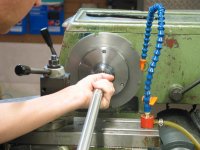Wounded Eagle
Plastic
- Joined
- Jun 4, 2012
- Location
- Grantsville, Utah, USA
Seems like a lot of people want a muzzle break added to their rifles lately. I've been taking the actions off of the barrels so I can indicate both ends of the barrel in my lathe to get the most accurate class 3 threads possible for screwing on the break concentric to the bore.
Kind of takes a lot of effort on some rifles. Has any one got a system that works for them that might not be so labor intensive?
Any information folks might like to pass along concerning installation of muzzle breaks would be most welcome.
Kind of takes a lot of effort on some rifles. Has any one got a system that works for them that might not be so labor intensive?
Any information folks might like to pass along concerning installation of muzzle breaks would be most welcome.




